Storing water may be the most vital part of our preparations for SHTF events as we need daily intakes of water to keep our bodies functioning properly.
We may be able to survive for up to 2 months without food. However, we can barely last past 3-5 days without fluids or water.
Public water supplies could be disrupted due to drought, floods, quakes, pollution or civil unrest. The need for a stored supply of water is essential for our survival.
Being such an important aspect of our preparations, we need to make sure that the water is stored in the correct ways. Otherwise, we may risk catching some serious diseases that could end up being fatal.
Not Storing Water In Sealed Containers
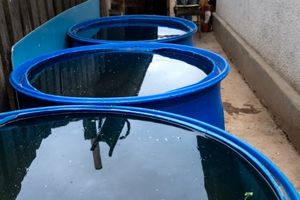 If your water containers are not sealed, they are open to all manner of airborne contaminants and other things that can drop into the containers.
If your water containers are not sealed, they are open to all manner of airborne contaminants and other things that can drop into the containers.
These contaminants will pollute the water causing certain bacteria to grow, making it unsafe to drink, and even dangerous for your health.
Related: What Is The Best Way To Store Water For SHTF?
It may also attract mosquitoes and other parasites to multiply in the stagnant water.
All containers need to be sealed tightly to make sure the water will stay potable for a long time.
Not Storing Water In The Right Conditions
All your long term water storage needs to be kept in clean, cool, dry and dark conditions, preferably off cement floors. The ideal places are basements, pantries with no windows, underground cellars and temperature controlled garages.
⇒ Cheap And Easy Way To Build A Root Cellar In Your Backyard
It is important to keep plastic and glass water containers cool and away from sunlight so that chemicals are not released from the containers into the stored water.
Plastic containers in particular need to be kept away from the strong smelling odors of chemicals, fuels, paints etc. These odors can permeate the plastic containers.
Repurposing Previously Used Food Grade Containers
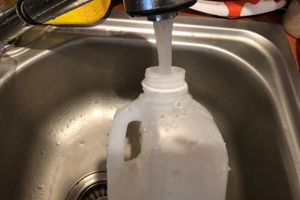 Some people say that previously used food grade containers such as those that held soda, beer, milk or oil etc. can be reused.
Some people say that previously used food grade containers such as those that held soda, beer, milk or oil etc. can be reused.
However, even the most careful sanitizing will not get rid of all the contaminants and some traces of bacteria and sugar will remain.
The exception to this is the reusing of bottles that contained water.
These can be reused as long as they are washed and sanitized with a bleach solution of 1 teaspoon bleach to 1 quart of water.
Not Using The Right Additives
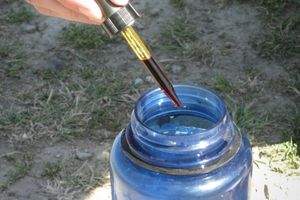
Water meant for long term storage needs to be purified before it is sealed to ensure it will be good to use when needed.
There are a number of additives that can be used for purifying water including chlorine, calcium, fluorine, iodine tablets or tincture.
Another thing to be careful about is ensuring the dates on the iodine or water purification tablets have not expired.
Chlorine also needs to be fresh as it loses its strength when stored for 6 months and over. Bleach that is over 1 year old may need to be used at twice the dosing rate of fresh chlorine.
Storing Water In The Wrong Type Of Containers
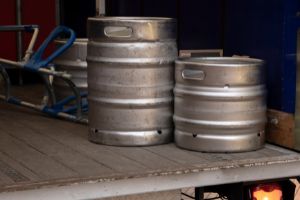 Water should not be stored in metal containers as the metal will rust quite quickly and spoil the water.
Water should not be stored in metal containers as the metal will rust quite quickly and spoil the water.
The exception is the use of stainless steel containers, but the biggest disadvantage with this is that chlorine cannot be used to sanitize the water as it will corrode the container.
This also includes not being able to fill your stainless steel containers with tap water as it has already been treated with chlorine.
Plastic containers are the go-to solution for a lot of people, but these must be food grade to minimize the leaching of dangerous chemicals into the water.
Glass containers are also a possibility, but whichever container you choose to use, they must be sanitized first with a chlorine solution.
Not Filtering Rainwater
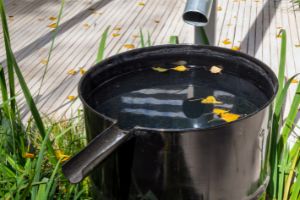
Harvesting rainwater is a great idea, but it can’t be taken for granted that it is suitable for drinking.
Many harmful bacteria can find their way into the water, causing serious diseases. Rainwater needs to be filtered as it enters the barrel, to prevent debris from polluting the water.
It also needs to be put through a 1 micron or less filter, so as to kill Giardia and Cryptosporidium parasites.
⇒ DIY Pressurized Rainwater Harvesting And Purification System
Bleach alone will not kill these parasites. But another effective method is to boil the water for at least 5 minutes to make it potable.
Using Too Much Bleach
The correct dosage to sanitize potable water is 8 drops or ⅛ teaspoon bleach to 1 gallon of water.
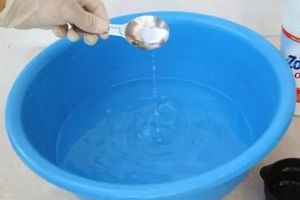
This dosage can be doubled for non-potable water (water from rivers, lakes etc.). It must be left for at least 30 minutes before drinking.
Bleach is a corrosive substance. If too much of it is used, it can cause serious damage when drunk and may even lead to death.
It is also important to use unscented bleach that contains 4-6% sodium hypochlorite which is the common concentration for most household bleaches.
Not Changing The Water Regularly And Accessing The Water Storage Improperly
Some people say that if the container and water have been sanitized and sealed tightly, it will stay good forever.
However, to be on the side of caution. It is necessary to change the stored water every year. If any seal is broken or the container is cracked, you need to change the water even earlier.
Related: Is it Safe to Drink Old Stored Water?
The containers and fresh water both need to be sanitized again and sealed tightly. The discarded water can be used to water your vegetables, wash dishes, flush toilets or to do laundry.
Care must also be taken when accessing the water. You have to make sure bacteria is not introduced to the water via hands or ladles. It is recommended that a spout or spigot is used to avoid this type of contamination.
Water is going to be one of your most precious assets and needs to be stored properly.
This means using food grade containers. They need to be sanitized, filled with purified water, sealed tightly, stored in the right conditions.
A supply of bleach, filters and fuel will also help you make use of other sources of water when SHTF.

No comments:
Post a Comment